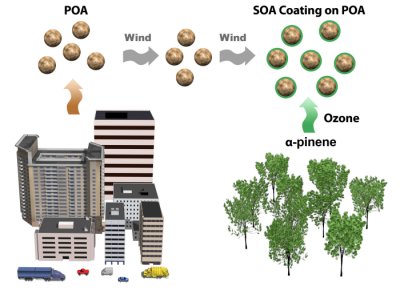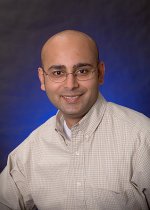Research Highlights
December 2007
Remodeling Atmospheric Organic Aerosols
Study reveals discrepancy in approach commonly used to model organic aerosol formation at global scales
Results: A recent study led by Dr. Rahul Zaveri of Pacific Northwest National Laboratory revealed a significant discrepancy between how organic aerosols may form in nature and a semi-empirical approach commonly used in global aerosol models to study the effects of organic aerosols on climate change. The semi-empirical approach is based on the theory of gas absorption in organic liquids and experimental data on organic aerosol formation, but makes certain assumptions on how the organic gases may partition between the gas and particulate phases. Because atmospheric aerosols affect Earth's climate by influencing cloud formation and by absorbing or reflecting the Sun's energy, such discrepancies could have large implications for global models that simulate the effects of human induced and natural organic aerosols on climate. Results of the team's research appeared in the October issue of Geophysical Research Letters.
Why it matters: Aerosols are microscopic solid particles and/or liquid droplets dispersed in the atmosphere. A large fraction of aerosols are organic (carbon-containing), and occur in two forms: primary and secondary. Primary organic aerosols, or POA, are directly emitted into the atmosphere through diesel and gasoline vehicle exhaust, as well as during meat cooking and biomass burning. Secondary organic aerosols, or SOA, are formed from gas-to-particle conversion of trace amounts of oxidized hydrocarbon vapors in the atmosphere. The POA particles in urban areas are typically composed of lubricating oil compounds which are water insoluble, or hydrophobic, while the SOA compounds are more water soluble, or hydrophilic. The hydrophobic and hydrophilic compounds are typically incompatible, much like oil and water. The chemistry of SOA formation is a complex interaction between the trace organic gases and aerosols, but some basic scenarios have been characterized using model systems.

Recent findings by PNNL researchers and their colleagues indicate that biogenic SOAs—like α-pinene—may not form a homogenous mixture with urban hydrophobic POAs, but rather condense as a separate phase, possibly a “coating” as illustrated above. Enlarge image
One example of SOA formation involves α-pinene—a gaseous organic compound emitted by trees—which is known to react with ozone and other oxidants in the atmosphere to produce oxygenated organic vapors. According to the semi-empirical modeling approach used in climate models, these vapors condense onto pre-existing POA particles to form SOA. The model assumes a single, well-mixed SOA+POA organic phase, which significantly enhances the modeled SOA yields.
In contrast to this semi-empirical treatment, Zaveri and his colleagues found that SOA formation is insensitive to the presence of hydrophobic POA. Their results suggest that SOA forms a separate and distinct phase—possibly a coating—upon condensing onto the POA. If these results are found to apply to other biogenic SOA precursors, then global simulations using the semi-empirical approach would predict significantly less SOA than previously estimated. This would widen the large discrepancies already found between the observed and predicted amounts of organic aerosol masses around the world.

Dr. Chen Song stands in front of the “smog chamber” designed to simulate a micro-environment for studying aerosol formation.
Methods: To investigate the critical assumption of a well-mixed SOA+POA organic phase, the research team conducted experiments in a "smog chamber"—an 8000 liter Teflon bag reactor—at PNNL for studying atmospheric chemistry in a controlled environment. In addition to its nonreactive surface, the chamber includes ports for injecting and withdrawing gas and aerosol samples for continuous analyses, and a bank of fluorescent lights provide simulated “sunlight” to carry out photochemical reactions that occur naturally in the real atmosphere. Most importantly, the relatively large volume-to-surface area ratio increases the amount of time the suspended particles are available for analysis.
Using dioctyl phthalate and lubricating oil aerosols as surrogates for urban hydrophobic POA, they measured SOA formation and growth by oxidizing α-pinene in the absence and presence of the oil aerosol. To quantify the SOA yields, the researchers used state-of-the-art instrumentation from DOE's Environmental Molecular Sciences Laboratory, including an Aerodyne aerosol mass spectrometer, a single-particle mass spectrometer, and a proton-transfer reaction mass spectrometer.
Next steps: Further research will be necessary to fully understand the chemistry and mechanism of SOA formation. In the future, the team will mimic atmospherically relevant conditions in their smog chamber and compare the findings to real-world aerosol samples. They will also develop a comprehensive SOA model, which will be used to interpret both the smog chamber and field observations.
Research team: Rahul Zaveri, Chen Song, Xiao-Ying Yu and David Maughan from PNNL's Atmospheric Science and Global Change Division; Alla Zelenyuk from PNNL's Chemical & Materials Sciences Division; Lizabeth Alexander, John Ortega, and Alexander Laskin from the Environmental Molecular Sciences Laboratory; Joel Thornton from the University of Washington; and Sasha Madronich from the Atmospheric Chemistry Division at the National Center for Atmospheric Research in Boulder, Colorado.
Sponsor: The team's research was funded by PNNL's Laboratory Directed Research and Development program and by EMSL.
Reference: Song C, RA Zaveri, ML Alexander, JA Thornton, S Madronich, JV Ortega, A Zelenyuk, X-Y Yu, A Laskin, and D Maughan. 2007. "Effect of hydrophobic primary organic aerosol on secondary organic aerosol formation from ozonolysis of α-pinene." Geophysical Research Letters 34, L20803, doi:10.1029/2007GL030720.

